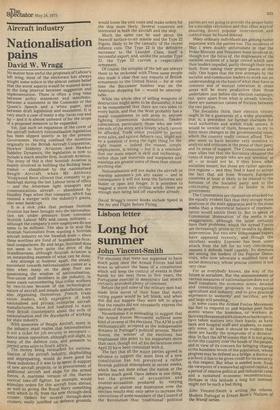Aircraft industry
Nationalisation pains
David W. Wragg
No matter how awful the proposals of Labour's left wing, most of the electorate has always sought some solace in the almost certain belief that the worst aspects would be watered down in the long interval between suggestion and implementation. There is often a long time between policy statement and manifesto, between a statement in the Commons or the Queen's Speech and a white paper, and between draft legislation and enactment. It is very much a case of many a slip 'twixt cup and lip — and it is almost unheard of for the scope of a proposed measure to be expanded. Yet, just such an expansion of the cover of the aircraft industry nationalisation legislation has been slipped quietly in by the present Government. Having confined the intention originally to the British Aircraft Corporation, Hawker Siddeley Aviation and Hawker Siddeley Dynamics, the legislation is now to include a much smaller firm, Scottish Aviation. The irony of this is that Scottish Aviation is mainly involved in building the Bulldog basic trainer — abandoned by the nationalised Beagle Aircraft, when Mr Anthony Wedgwood Senn allowed that company to go bankrupt during the last Labour term of office — and the Jetstream light transport and communications aircraft — abandoned by Handley Page when that company, which has resisted a merger with the industry's giants, also went bankrupt. It is a sick joke that perhaps Scottish Aviation has been brought into the nationalisation net under pressure from extremist Scottish Labour MPs and union militants — although the company's own employees do not seem to be militant. The idea is to stop the Scottish Nationalists from wanting a Scottish aricraft industry on the Swedish scale — since these worthies are fond of Scandinavia-Scotland comparisons. By and large, Scotland does not seem to have quite the drive of the Scandinavians, although Scottish Aviation is an outstanding example of what can be done. Any attempt at humour apart, the steady movement towards nationalisation comes at a time when many on the shop floor are questioning the wisdom of nationalisation. Non-union staff members in the industry, in some cases outnumbering blue collar workers by two-to-one because of the technological nature of aircraft and missile manufacture, are also organising themselves. French trade union leaders, with experience of both nationalised and private enterprise aircraft manufacturers, have not hesitated to warn their British counterparts about the evils of nationalisation and the drawbacks of working for state industry.
With memories of Beagle Aircraft, many in the industry must realise that nationalisation IS not a ticket for job security in aerospace — hence union opposition, although still slight, to many of the defence cuts, and pressure to *permit arms sales to South Africa.
The money being earmarked for nationalisation of the aircraft industrY, shipbuilding and shiprepairing, would do more good for these industries if it was to be spent in support of new aircraft projects, or in procurement of additional aircraft and ships for the armed forces. A maritime version of the Harrier vertical take-off fighter, for example, would istimulate orders for this aircraft from abroad, as well as giving the Royal Navy something with which to fly from the new through-deck cruiser. Orders for several through-deck cruisers, easily justified on defence grounds, would lower the unit costs and make orders for the ship more likely. Several countries are interested in both the aircraft and the ship.
Much the same can be said about the Seawolf surface-to-air missile and the Type 22 frigate, likely to be the casualty of the recent . defence cuts. The Type 22 is the definitive successor to the Leander Class, itself a successful export, and, unlike the interim Type 21, the Type 22 carries a respectable armament.
Of course, the scruples of the left are always there to be reckoned with.These same people also made it clear that any exports of British armaments to the United States — for at one time the Buccaneer laipmber was on the American shopping list — would be unacceptable.
While the whole idea of selling weapons of destruction might seem to be distasteful, it has to be remembered that there are two sides to every battle, and that the West probably has a moral commitment to sell arms to anyone fighting Communist domination. Tender consciences, particularly those who see only one side of the story, are a luxury which cannot be afforded. Trade union pressure to permit arms sales, and against defence cuts, might not be a question of doing the right thing for the right reason — indeed the reason, simply employment, is wrong — but it is a reminder that our main export is skill and technology, rather than raw materials and warplanes and warships are greater users of them than almost anything else.
Nationalisation will not make the aircraft or warship salesmen's job any easier — and in consequence it will not keep the factories any busier or open any longer. It is pointless to suggest a move into civilian work; there are enough men being laid off elsewhere already.
David Wragg's recent books include Speed in the Air and Flight Before Flying.


























 Previous page
Previous page